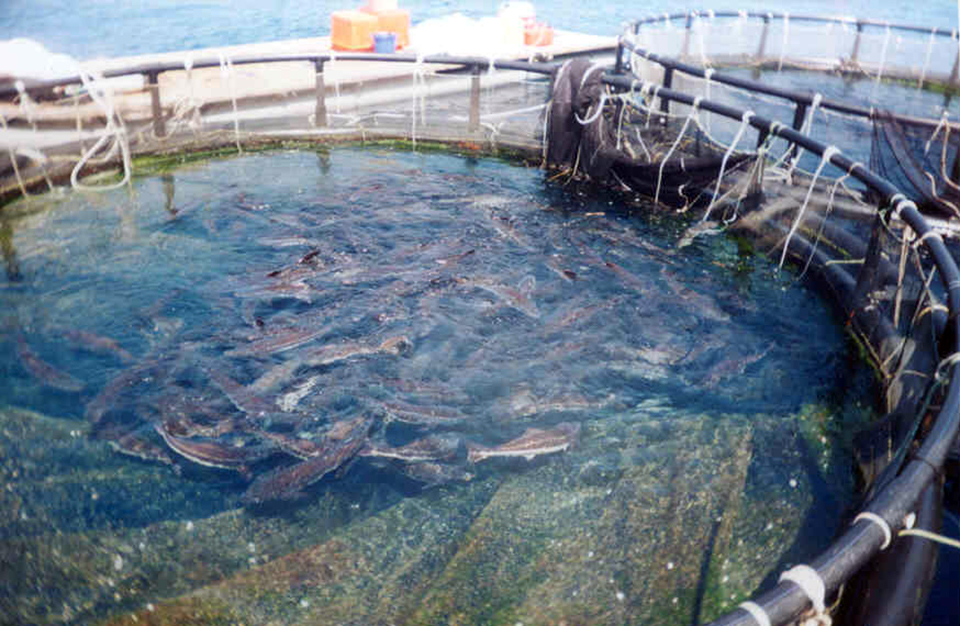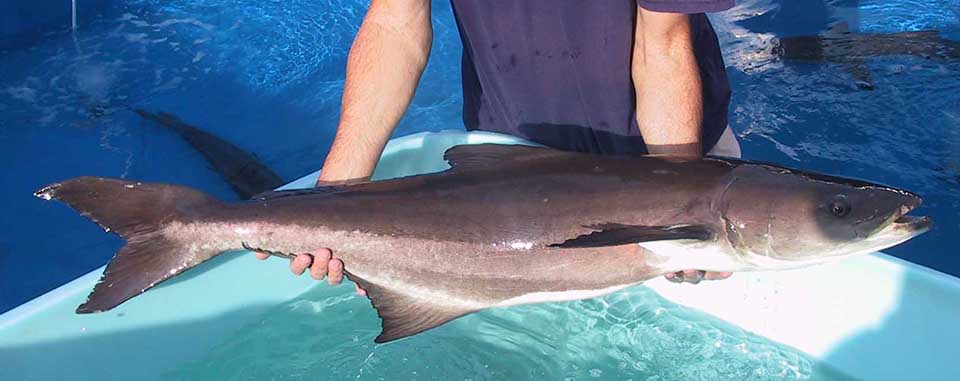Cobia (Rachycentron canadum)

The hatchery and cage culture of cobia in Taiwan, where these fish are known as “lings,” has developed into a successful industry. The country’s cobia aquaculture production in sea cages in 1999 and 2000 was around 500 metric tons (MT) each year, comprising 48 percent of Taiwan’s total cage culture production (Yeh 2000; Liao 2001). Serious efforts are now under way to determine the feasibility of developing offshore aquaculture of cobia in the United States and the Caribbean.
Species distribution
Cobia is the only species in the family Rachycentridae. It is widely distributed in temperate to tropical waters in the Atlantic, throughout the Caribbean, and in the Indo-Pacific off India, Australia and Japan. Cobia are found in shallow areas of the open ocean, often associated with pilings, buoys and other floating structures.
Aquaculture suitability
Several characteristics make cobia suitable for commercial culture. These include ease of spawning, large egg size (1.4 mm), and the resulting ease of larval rearing and fingerling production. Fast growth, high survival rates through the first year, and low feed-conversion ratios are additional positives.
Environmental requirements
Cobia can tolerate wide variations in temperature (16.8 to 32.2 degrees-C) and salinity (22.5 to 44.5 ppt). Juveniles handle temperatures as low as 17.7 degrees-C, but cease feeding at 18.3 degrees-C. Larvae have been raised in salinities as low as 19 ppt.
Reproduction
First maturity reportedly occurs during the second year for males (at about 52 cm fork length) and third year for females of about 70 cm FL. However, a 43-cm (total length) female with ripe ovaries was reported from India.
In the wild, cobia spawn from the spring through fall in subtropical and tropical regions. Populations from temperate areas have a more pronounced summer spawning peak. They form spawning aggregations and are gonochoristic; no sexual dimorphism is observed. Cobia are highly fecund and can produce millions of eggs each spawning.
Growth and fillet yield
Cobia have been reported to grow from eggs to 80 g in two months, and to 8 kg in one year. In addition, they have a very high yield for dressed fillets of over 60 percent total body weight. This equals or surpasses the yield of Atlantic salmon, a highly successful aquaculture species. Cobia can reach more than double the weight of salmon after the first year of culture in cages.
Behavior
In captivity, juveniles and adults exhibit nonaggressive behavior and swim in formation. After feeding, cobia generally settle to the tank bottom and rest on their pectoral fins and tails to quietly digest their meals.
Early cobia culture in U.S.
Initial efforts to culture cobia in the United States go back to the 1970s, when in North Carolina, Hassler and Rainville used eggs collected from plankton tows. Another effort to keep cobia in captivity took place in 1991 in Port Aransas, Texas. C. Arnold and collaborators captured about a dozen juveniles under floating patches of Sargassum sp. weed and maintained them in a 3.6-meter-diameter circular tank for one year.
Current programs
Cobia broodstock are now kept in several U.S. states, including Virginia, Texas, Mississippi, South Carolina, and Florida. Cobia spawnings using hormone injections and manipulation of environmental parameters have been recently reported in Virginia, Texas, and South Carolina.
Research in Florida
Large cobia broodstock (7 to 20 kg) are currently being held by two private companies: Aquaculture Center of the Florida Keys (ACFK) in Marathon and Maritech in Vero Beach. All fish were collected by Dynasty Marine Associates, a Marathon company that specializes in the capture and transport of large marine animals. Handling and acclimation at the facilities were straightforward, and prophylaxis was conducted according to standard protocols (Benetti and Feeley 1999; Alarcón and Benetti 2001).
At the ACFK, broodstock fish are held in one 6-m-diameter, 1.8 meters deep, environmentally controlled recirculating tank. The short-term goal there is to initiate the natural cycle of “recrudescence.” Recrudescence refers to the time required for rebuilding the female ovary after cessation of spawning at the end of a season to just before the next spawning season, when the ovary is again fully functional.
Broodfish are being held for the next several months at water temperatures around 20 degrees-C and short day lengths of about 10 hours of light. Subsequently, water temperatures will be gradually increased over four or five weeks to 25 to 26 degrees-C. In addition, longer day lengths of 14 hours will help initiate natural spawning.

Promising species
The offshore cage culture industry in the Americas and the Caribbean is still in its early stages, but cobia is already considered one of the more promising species for such aquaculture. To help guide its future, a September 2000 summit meeting on cobia sponsored by the National Sea Grant Program in Mississippi, USA set forth five research and outreach priorities. These areas included reproductive, hatchery and grow-out technology; environmental compatibility; economic feasibility and marketing; policy and regulation; and technology transfer, outreach, and education.
Conclusion
Cobia culture in net pens is a successful commercial enterprise in Taiwan. Cobia is also an excellent candidate species for the offshore aquaculture industry in the United States and the Caribbean. Current efforts to develop hatchery and grow-out technology involve several universities and private companies, with support from the National Oceanic and Atmospheric Administration through the National Marine Aquaculture Initiative and the Sea Grant Program.
Note: Cited references are available from the author.
(Editor’s Note: This article was originally published in the April 2002 print edition of the Global Aquaculture Advocate.)
Now that you've finished reading the article ...
… we hope you’ll consider supporting our mission to document the evolution of the global aquaculture industry and share our vast network of contributors’ expansive knowledge every week.
By becoming a Global Seafood Alliance member, you’re ensuring that all of the pre-competitive work we do through member benefits, resources and events can continue. Individual membership costs just $50 a year. GSA individual and corporate members receive complimentary access to a series of GOAL virtual events beginning in April. Join now.
Not a GSA member? Join us.
Authors
-
Daniel D. Benetti, Ph.D.
Assistant Professor
University of Miami
MAF Division, RSMAS
4600 Rickenbacker Causeway
Miami, Florida 33149 USA[117,100,101,46,105,109,97,105,109,46,115,97,109,115,114,64,105,116,116,101,110,101,98,100]
-
Refik Orhun, Ph.D.
University of Miami
MAF Division, RSMAS
4600 Rickenbacker Causeway
Miami, Florida 33149 USA
Tagged With
Related Posts

Intelligence
Aquaculture of pelagic fish, part 1
Cage culture of yellowtail (Seriola quinqueradiata) in Japan is one of the most traditional and profitable aquaculture industries worldwide.

Intelligence
Aquaculture of pelagic fish, part 2
Australia’s aquaculture industry is developing rapidly, fueled by southern bluefin tuna (Thynnus maccoyii) in offshore net cages.

Intelligence
Aquaculture of pelagic fish, part 3
Supporting the global growth of pelagic fish aquaculture will require more efficient, cost-effective and environmentally sustainable methodology.

Intelligence
Aquaculture of pelagic fish, part 4
Mahimahi, also known as dolphin fish and dorado, has long been recognized as a high-value pelagic fish with excellent potential for aquaculture.


